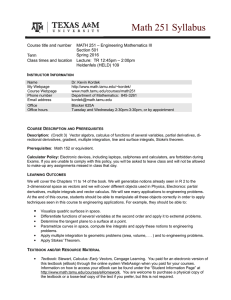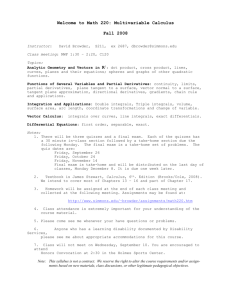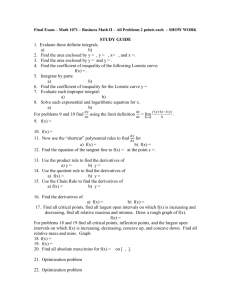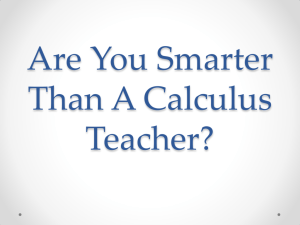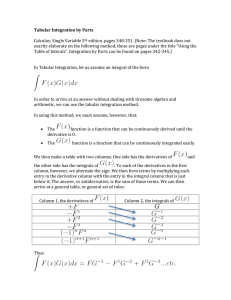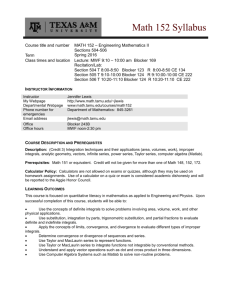Engineering Mathematics III
advertisement
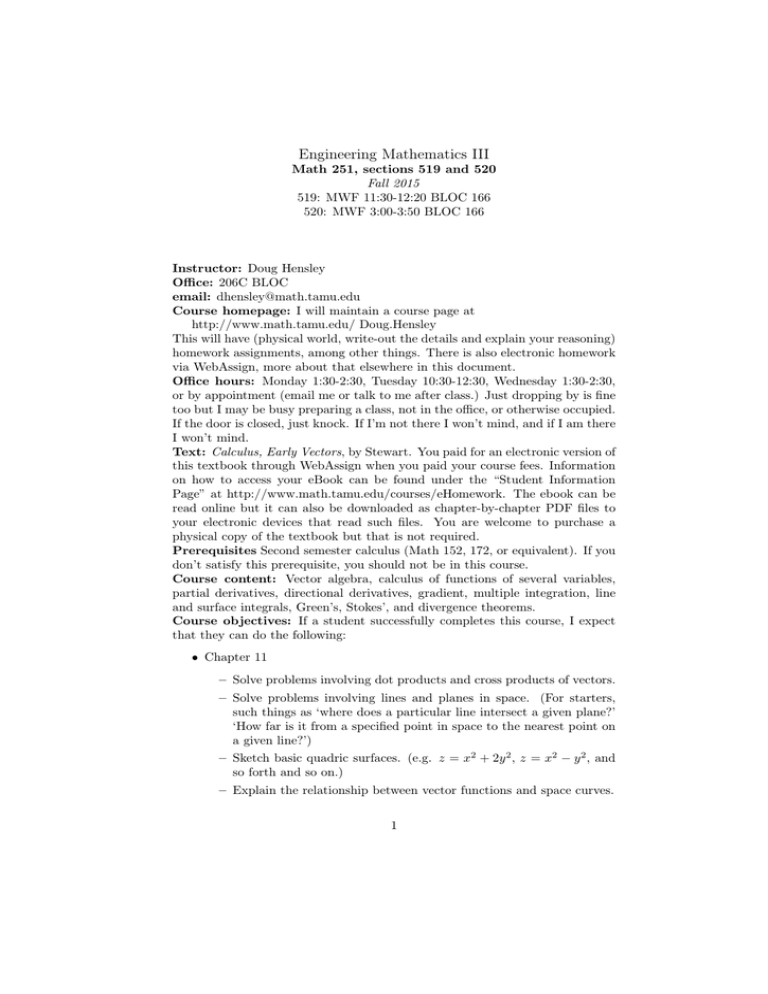
Engineering Mathematics III Math 251, sections 519 and 520 Fall 2015 519: MWF 11:30-12:20 BLOC 166 520: MWF 3:00-3:50 BLOC 166 Instructor: Doug Hensley Office: 206C BLOC email: dhensley@math.tamu.edu Course homepage: I will maintain a course page at http://www.math.tamu.edu/ Doug.Hensley This will have (physical world, write-out the details and explain your reasoning) homework assignments, among other things. There is also electronic homework via WebAssign, more about that elsewhere in this document. Office hours: Monday 1:30-2:30, Tuesday 10:30-12:30, Wednesday 1:30-2:30, or by appointment (email me or talk to me after class.) Just dropping by is fine too but I may be busy preparing a class, not in the office, or otherwise occupied. If the door is closed, just knock. If I’m not there I won’t mind, and if I am there I won’t mind. Text: Calculus, Early Vectors, by Stewart. You paid for an electronic version of this textbook through WebAssign when you paid your course fees. Information on how to access your eBook can be found under the “Student Information Page” at http://www.math.tamu.edu/courses/eHomework. The ebook can be read online but it can also be downloaded as chapter-by-chapter PDF files to your electronic devices that read such files. You are welcome to purchase a physical copy of the textbook but that is not required. Prerequisites Second semester calculus (Math 152, 172, or equivalent). If you don’t satisfy this prerequisite, you should not be in this course. Course content: Vector algebra, calculus of functions of several variables, partial derivatives, directional derivatives, gradient, multiple integration, line and surface integrals, Green’s, Stokes’, and divergence theorems. Course objectives: If a student successfully completes this course, I expect that they can do the following: • Chapter 11 – Solve problems involving dot products and cross products of vectors. – Solve problems involving lines and planes in space. (For starters, such things as ‘where does a particular line intersect a given plane?’ ‘How far is it from a specified point in space to the nearest point on a given line?’) – Sketch basic quadric surfaces. (e.g. z = x2 + 2y 2 , z = x2 − y 2 , and so forth and so on.) – Explain the relationship between vector functions and space curves. 1 – Differentiate vector functions and use this to find tangents to space curves. – Relate position, velocity, and acceleration of a particle moving in three dimensional space. (For instance, if the acceleration is always perpendicular to the direction of motion, what does this say about the speed of the particle? [There’s a tie-in to physics here.]) • Chapter 12 – Determine domain, range, and level sets of a function of several variables. – In simple cases, determine whether a function of several variables has a limit. – Find partial derivatives, both from the definition and from derivative rules. – Use differentials to approximate functions of several variables. – Verify whether a function of several variables satisfies the definition of differentiability. – Calculate directional derivatives. – Find extrema of a function of several variables, both with and without constraints. (What is the maximum value of x2 + xy + 2y 2 subject to x2 + y 2 ≤ 1?) • Chapter 13 – Explain the definition of multiple integrals in terms of Riemann sums. – Evaluate multiple integrals over general regions. – Describe curves in polar coordinates, and surfaces in cylindrical and spherical coordinates. – Use multiple integrals in applies problems. – Evaluate multiple integrals by making a change of coordinates. • Chapter 14 – Evaluate line integrals by ∗ using a parametrization. ∗ using the fundamental theorem of line integrals. ∗ using Green’s theorem. ∗ using Stokes’ theorem. – Calculate curl and divergence of a vector field. – Find parametrizations of surfaces. – Find areas of parametrized surfaces and tangent planes to them. – Set up and evaluate surface integrals. – Use the divergence theorem to convert between triple integrals and surface integrals. 2 Grading: There will be three tests, each worth 100 points. The final exam will be comprehensive and worth 200. WebAssign homework will be worth 60 points, and paper homework will be worth 60 points. Your final grade will be based on the sum of these numbers: 540 or more is an A, 480 to 539 a B, and so on. In cases where the student has obtained a poor result on one exam but the final exam reflects substantial improvement since then on the topic of that one exam, an adjustment may be made. Homework: WebAssign homework will be due by 11:55 PM on Mondays. Access to WebAssign was included in your course fees. See http://www.math.tamu.edu/course/eHomework/ for more information. Late eHomework cannot be accepted. I will drop your two lowest eHomework section scores. I will also assign a few problems as paper homework. Here, the grader can grade your work and your explanations as well as your answers. Your lowest two paper homework assignments will also be dropped. Discussing homework with me or your fellow students is OK, but passing off someone else’s work as your own is not. (This includes copying from a solutions manual) and is a violation of the Aggie Honor Code. While we’re at it, with the kind permission of Prof. Tom Vogel, I lifted large parts of this syllabus from his. Since I’m not passing it off as my own, it’s not plagiarism. Where to go for help: There will be a help session for this class. I will announce location and time once these have been set. The whole purpose of office hours is to provide students with individualized help; please use them. The math department also keeps a list of tutors it deems qualified (ask at Blocker 227). How to study: The key to facility in mathematical problem solving is sustained engagement with problems that are difficult enough to present a challenge but tractable enough not to present an insurmountable challenge. There is an enormous difference between ‘insurmountable challenge’ and ‘too hard to see right off how to do it’. Stay with it. Come back to it. Come by the office and get some pointers. The key to learning facts, definitions, and methods in such a way as to remember them later (and much later) is effortful recall. You may have your best results by giving the material you want to remember a rest before trying to retrieve it from memory. The attempt to do so, even if it comes up dry and you have to go back and look up the answer again, seems to help cement the memory. The key to optimal use of instructional time is give-and-take. If you have a question, but fear that it will merely reveal your ignorance, take heart. There are almost certainly many others in the class in the same boat. Go ahead and ask. They’ll be relieved, you’ll get an answer to your question, and I’ll be glad of an opportunity to clarify. Little factoid: during the ‘Manhattan project’, the top scientists designing the first nuclear weapons made it their rule that no one must keep silent for fear of seeming ignorant. Their pact meant that they could admit to not getting ‘it’, clear up their confusion, and forge ahead. That’s the right spirit. 3 Tests: Tests will be given on 9/30, 10/28, and 12/2 during class time with reviews to be given the previous Sundays from 6 to 9 pm at locations to be announced. The sections covered on a test will be announced well in advance. You will need to bring your own Scantron sheet. Simple calculators (add, subtract, multiply, divide, square root) will be allowed on tests, but not programmable, graphic, or algebraic devices. If you must miss a test due to a University-excused absence (see http://student-rules.tamu.edu/rule07) notify me before the test if possible, but in any event promptly thereafter. Copyright: The handouts for this course are copyrighted. You may make single copies for personal use, but they may not be mass-copied nor incorporated into other documents or stored with third parties without my express written permission. Disabilities: The Americans with Disabilities Act (ADA) is a federal antidiscrimination statute that provides comprehensive civil rights protection for persons with disabilities. Among other things, this legislation requires that all students with disabilities be guaranteed a learning environment that provides for reasonable accommodation of their disabilities. If you believe that you have a disability requiring an accommodation, please contact Disability Services, in Cain Hall, room B118, email them at disability@tamu.edu, or go to their website at http://disability.tamu.edu for more information. Academic integrity: An Aggie does not lie, cheat, or steal, or tolerate those who do. For more information on the honor code, please refer to http://www.tamu.edu/aggiehonor. I hold myself, and my students, to this standard. Final Exams: • Section 519 (MWF 11:30-12:20) is Wednesday Dec 16 at 10:30 AM. • Section 520 (MWF 3:00-3:50) is Tuesday, Dec 15 at 10:30 AM. If you have three finals scheduled on the same day, and you don’t already have a final for the same time as the other class, you can take theirs. Tentative schedule • Week 1: Material from Stewart, sections 11.1-11.4 • Week 2: 11.5-11.7 • Week 3: 11.8, 12.1, 12.2, and 13.4 • Week 4: 12.3, 12.4, 12.5 • Week 5: 12.6, Exam 1 (Wednesday Sept 30), 12.7 • Week 6: 12.7, 12.8, 13.1 • Week 7: 13.2, 13.3, 13.5 • Week 8: 13.5 continued, 13.6, 13.7, 13.8 4 • Week 9: 13.9, 13.10, Exam 2 (Wednesday Oct 28), 13.11 • Week 10: 13.11 continued, 14.1, 14.2 • Week 11: 14.2 continued, 14.3, 14.4 • Week 12: 14.4 continued, 14.5, 14.6, 14.7 • Week 13: 14.7 continued • Week 14: 14.7 wrap, Exam 3 (Wednesday Dec 2), 14.8 • Week 15: 14.9, Review. 5

